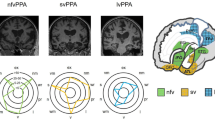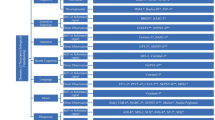Abstract
Disease-modifying therapies are being developed to target tau pathology, and should, therefore, be tested in primary tauopathies. We propose that progressive apraxia of speech should be considered one such target group. In this study, we investigate potential neuroimaging and clinical outcome measures for progressive apraxia of speech and determine sample size estimates for clinical trials. We prospectively recruited 24 patients with progressive apraxia of speech who underwent two serial MRI with an interval of approximately 2 years. Detailed speech and language assessments included the Apraxia of Speech Rating Scale and Motor Speech Disorders severity scale. Rates of ventricular expansion and rates of whole brain, striatal and midbrain atrophy were calculated. Atrophy rates across 38 cortical regions were also calculated and the regions that best differentiated patients from controls were selected. Sample size estimates required to power placebo-controlled treatment trials were calculated. The smallest sample size estimates were obtained with rates of atrophy of the precentral gyrus and supplementary motor area, with both measures requiring less than 50 subjects per arm to detect a 25 % treatment effect with 80 % power. These measures outperformed the other regional and global MRI measures and the clinical scales. Regional rates of cortical atrophy, therefore, provide the best outcome measures in progressive apraxia of speech. The small sample size estimates demonstrate feasibility for including progressive apraxia of speech in future clinical treatment trials targeting tau.



Similar content being viewed by others
References
Boxer AL, Lang AE, Grossman M, Knopman DS, Miller BL, Schneider LS et al (2014) Davunetide in patients with progressive supranuclear palsy: a randomised, double-blind, placebo-controlled phase 2/3 trial. Lancet Neurol 13:676–685
Litvan I, Agid Y, Calne D, Campbell G, Dubois B, Duvoisin RC et al (1996) Clinical research criteria for the diagnosis of progressive supranuclear palsy (Steele-Richardson-Olszewski syndrome): report of the NINDS-SPSP international workshop. Neurology 47:1–9
Tolosa E, Litvan I, Hoglinger GU, Burn D, Lees A, Andres MV et al (2014) A phase 2 trial of the GSK-3 inhibitor tideglusib in progressive supranuclear palsy. Mov Disord 29:470–478
Josephs KA, Dickson DW (2003) Diagnostic accuracy of progressive supranuclear palsy in the Society for Progressive Supranuclear Palsy brain bank. Mov Disord 18:1018–1026
Paviour DC, Price SL, Lees AJ, Fox NC (2007) MRI derived brain atrophy in PSP and MSA-P. Determining sample size to detect treatment effects. J Neurol 254:478–481
Whitwell JL, Xu J, Mandrekar JN, Gunter JL, Jack CR Jr, Josephs KA (2012) Rates of brain atrophy and clinical decline over 6 and 12-month intervals in PSP: determining sample size for treatment trials. Parkinsonism Relat Disord 18:252–256
Golden E, Duffy JR, Strand EA, Parisi JE, Dickson DW, Josephs KA (2014) Primary progressive apraxia of speech associated with progressive supranuclear palsy pathology. Am J Neurodegener Dis 3:131 [conference abstract]
Josephs KA, Boeve BF, Duffy JR, Smith GE, Knopman DS, Parisi JE et al (2005) Atypical progressive supranuclear palsy underlying progressive apraxia of speech and nonfluent aphasia. Neurocase 11:283–296
Josephs KA, Duffy JR, Strand EA, Whitwell JL, Layton KF, Parisi JE et al (2006) Clinicopathological and imaging correlates of progressive aphasia and apraxia of speech. Brain 129:1385–1398
Duffy JR (2005) Motor speech disorders: substrates, differential diagnosis, and management. Mosby, St Louis
Josephs KA, Duffy JR, Strand EA, Machulda MM, Senjem ML, Lowe VJ et al (2013) Syndromes dominated by apraxia of speech show distinct characteristics from agrammatic PPA. Neurology 81:337–345
Josephs KA, Duffy JR, Strand EA, Machulda MM, Senjem ML, Master AV et al (2012) Characterizing a neurodegenerative syndrome: primary progressive apraxia of speech. Brain 135:1522–1536
Deramecourt V, Lebert F, Debachy B, Mackowiak-Cordoliani MA, Bombois S, Kerdraon O et al (2010) Prediction of pathology in primary progressive language and speech disorders. Neurology 74:42–49
Dickson DW, Ahmed Z, Algom AA, Tsuboi Y, Josephs KA (2010) Neuropathology of variants of progressive supranuclear palsy. Curr Opin Neurol 23:394–400
Josephs KA, Duffy JR, Strand EA, Machulda MM, Senjem ML, Gunter JL et al (2014) The evolution of primary progressive apraxia of speech. Brain 137:2783–2795
Wicklund MR, Duffy JR, Strand EA, Whitwell JL, Machulda MM, Josephs KA (2013) Aphasia with left occipitotemporal hypometabolism: a novel presentation of posterior cortical atrophy? J Clin Neurosci 20:1237–1240
Borroni B, Alberici A, Grassi M, Turla M, Zanetti O, Bianchetti A et al (2010) Is frontotemporal lobar degeneration a rare disorder? Evidence from a preliminary study in Brescia county, Italy. J Alzheimer’s Dis 19:111–116
Johnson JK, Diehl J, Mendez MF, Neuhaus J, Shapira JS, Forman M et al (2005) Frontotemporal lobar degeneration: demographic characteristics of 353 patients. Arch Neurol 62:925–930
Whitwell JL, Duffy JR, Strand EA, Machulda MM, Senjem ML, Gunter JL et al (2013) Neuroimaging comparison of primary progressive apraxia of speech and progressive supranuclear palsy. Eur J Neurol 20:629–637
Strand EA, Duffy JR, Clark HM, Josephs K (2014) The apraxia of speech rating scale: a tool for diagnosis and description of apraxia of speech. J Commun Disord 51:43–50
Yorkson K, Strand EA, Miller R, Hillel A, Smith K (1993) Speech deterioration in amyotrophic lateral sclerosis: implications for the timing of intervention. J Med Speech Lang Pathol 1:35–46
Lewis EB, Fox NC (2004) Correction of differential intensity inhomogeneity in longitudinal MR images. Neuroimage 23:75–83
Freeborough PA, Fox NC (1997) The boundary shift integral: an accurate and robust measure of cerebral volume changes from registered repeat MRI. IEEE Trans Med Imaging 16:623–629
Gunter JL, Shiung MM, Manduca A, Jack CR Jr (2003) Methodological considerations for measuring rates of brain atrophy. J Magn Reson Imaging 18:16–24
Jack CR Jr, Wiste HJ, Knopman DS, Vemuri P, Mielke MM, Weigand SD et al (2014) Rates of beta-amyloid accumulation are independent of hippocampal neurodegeneration. Neurology 82:1605–1612
Tzourio-Mazoyer N, Landeau B, Papathanassiou D, Crivello F, Etard O, Delcroix N et al (2002) Automated anatomical labeling of activations in SPM using a macroscopic anatomical parcellation of the MNI MRI single-subject brain. Neuroimage 15:273–289
Acion L, Peterson JJ, Temple S, Arndt S (2006) Probabilistic index: an intuitive non-parametric approach to measuring the size of treatment effects. Statist Med 25:591–602
Newcombe RG (2006) Confidence intervals for an effect size measure based on the Mann-Whitney statistic. Part 1: general issues and tail-area-based methods. Statist Med 25:543–557
Gelman A, Hill J (2007) Data analysis using regression and multilevel/hierarchical models. Cambridge University Press, New York
Whitwell JL, Duffy JR, Strand EA, Xia R, Mandrekar J, Machulda MM et al (2013) Distinct regional anatomic and functional correlates of neurodegenerative apraxia of speech and aphasia: an MRI and FDG-PET study. Brain Lang 125:245–252
Litvan I, Kong M (2014) Rate of decline in progressive supranuclear palsy. Mov Disord 29:463–468
Hua X, Lee S, Yanovsky I, Leow AD, Chou YY, Ho AJ et al (2009) Optimizing power to track brain degeneration in Alzheimer’s disease and mild cognitive impairment with tensor-based morphometry: an ADNI study of 515 subjects. Neuroimage 48:668–681
Fox NC, Ridgway GR, Schott JM (2011) Algorithms, atrophy and Alzheimer’s disease: cautionary tales for clinical trials. Neuroimage 57:15–18
Ard MC, Edland SD (2011) Power calculations for clinical trials in Alzheimer’s disease. J Alzheimer’s Dis 26(Suppl 3):369–377
Hua X, Lee S, Hibar DP, Yanovsky I, Leow AD, Toga AW et al (2010) Mapping Alzheimer’s disease progression in 1309 MRI scans: power estimates for different inter-scan intervals. Neuroimage 51:63–75
Acknowledgments
This study was funded by R01-DC12519 (PI Whitwell), R01-DC010367 (PI Josephs) and U01-AG06786 (PI Petersen).
Conflicts of interest
The authors declare that they have no conflict of interest.
Ethical standard
The study was approved by the Mayo Clinic Institutional Review Board and was, therefore, performed in accordance with the ethical standards laid down in the 1964 Declaration of Helsinki and its later amendments. All subjects were consented for enrolment into the study.
Author information
Authors and Affiliations
Corresponding author
Rights and permissions
About this article
Cite this article
Whitwell, J.L., Duffy, J.R., Strand, E.A. et al. Sample size calculations for clinical trials targeting tauopathies: a new potential disease target. J Neurol 262, 2064–2072 (2015). https://doi.org/10.1007/s00415-015-7821-5
Received:
Revised:
Accepted:
Published:
Issue Date:
DOI: https://doi.org/10.1007/s00415-015-7821-5




